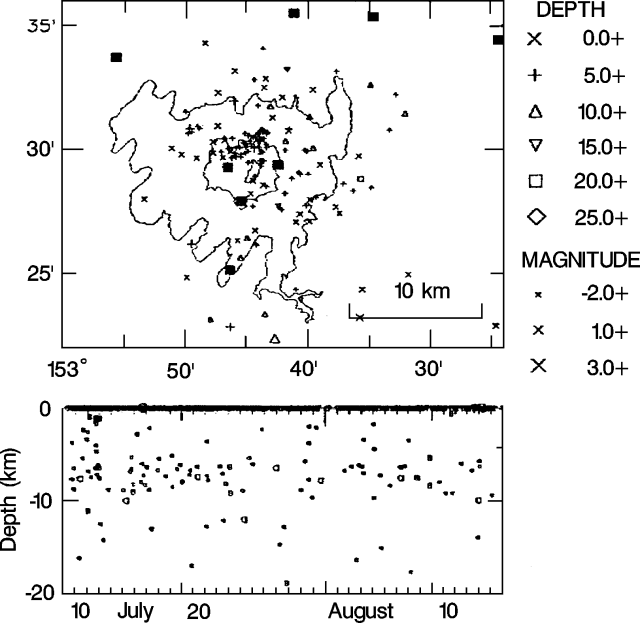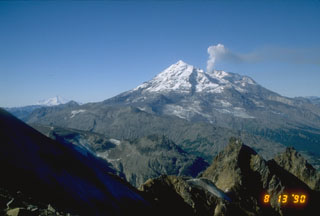Report on Redoubt (United States) — July 1990
Bulletin of the Global Volcanism Network, vol. 15, no. 7 (July 1990)
Managing Editor: Lindsay McClelland.
Redoubt (United States) No lava dome growth evident; seismicity low but above background
Please cite this report as:
Global Volcanism Program, 1990. Report on Redoubt (United States) (McClelland, L., ed.). Bulletin of the Global Volcanism Network, 15:7. Smithsonian Institution. https://doi.org/10.5479/si.GVP.BGVN199007-313030
Redoubt
United States
60.485°N, 152.742°W; summit elev. 3108 m
All times are local (unless otherwise noted)
This report covers the period 14 July-13 August 1990. "There were no explosive or seismic events at Redoubt during the report period. Seismic activity remained low. Earthquakes continued to occur at 4-10 km depth (figure 15), but were all below ML 1.5. Although seismic activity was low, it has not returned to pre-eruption levels.
 |
Figure 15. Epicenter map top and depth vs. time plot bottom of earthquakes recorded near Redoubt by AVO, 10 July-15 August, 1990. Squares on the epicenter map mark the positions of seismic stations. |
"Repeated observations of the lava dome indicated that its N face has been stable since late June. The S side of the dome has been largely obscured by clouds and steam since early June, but brief glimpses indicated that it too was largely unchanged.
"Four COSPEC flights in the last month yielded SO2 emission rates between 1,000 and 2,000 t/d. These values were slightly higher than those of the preceding report period, but remained in the lower third of values detected since measurements began on 20 March.
"Although seismicity has not yet returned to pre-eruption levels, other indications suggest that Redoubt is in a quiescent period. Therefore, no further communications regarding activity at Redoubt are forthcoming unless current conditions change."
Geological Summary. Redoubt is a glacier-covered stratovolcano with a breached summit crater in Lake Clark National Park about 170 km SW of Anchorage. Next to Mount Spurr, Redoubt has been the most active Holocene volcano in the upper Cook Inlet. The volcano was constructed beginning about 890,000 years ago over Mesozoic granitic rocks of the Alaska-Aleutian Range batholith. Collapse of the summit 13,000-10,500 years ago produced a major debris avalanche that reached Cook Inlet. Holocene activity has included the emplacement of a large debris avalanche and clay-rich lahars that dammed Lake Crescent on the south side and reached Cook Inlet about 3,500 years ago. Eruptions during the past few centuries have affected only the Drift River drainage on the north. Historical eruptions have originated from a vent at the north end of the 1.8-km-wide breached summit crater. The 1989-90 eruption had severe economic impact on the Cook Inlet region and affected air traffic far beyond the volcano.
Information Contacts: AVO Staff.

